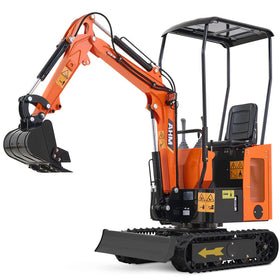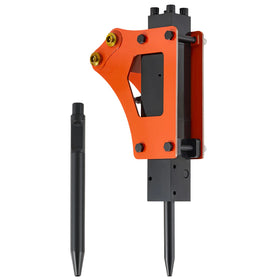Efficient mini-excavator performance relies on small, seemingly insignificant parts such as the bucket teeth. These are the cutting-edge, hardened steel points that your excavator uses to dig, rip, and tear things up.
They may appear unimportant, but your bucket teeth selection (and the care you take of teeth once they're installed) can make all the difference on-site.
This article will cover all you need to know about mini excavator bucket teeth, including how to determine the ones best suited for your applications. This holds true for compact machines like our 1-ton mini excavator with a 13.5 HP engine, where every component needs to work efficiently.

What are Excavator Bucket Teeth Types?
Not all bucket teeth are made from the same grade of steel. They are designed to serve various purposes and are made available in all forms, shapes, and sizes. Common excavator bucket teeth types and their uses include:
- Standard Bucket Teeth: The jack-of-all-trades. Generally speaking, these are good enough for general earthmoving and excavation under moderate abrasive conditions.
- Rock Bucket Teeth: These teeth are made with a thicker cross-section and harder steel composition than dirt teeth, capable of taking the pounding hits from cutting through rocky or frozen ground without quickly wearing down.
- Heavy Duty Bucket Teeth: These are the type of big bucket teeth and, therefore, made for hard work in very rough conditions, quarrying, mining, and demolition jobs. Resistance to abrasion as well as impact is high on the agenda when it comes to this kind of bucket teeth.
- Twin or Double-Acting Teeth: Designed with two cutting points, the versatile double-point design offers a self-sharpening benefit that increases tooth life and extends the period between replacements when compared to single-point designs.
In addition to these main categories, there are numerous subcategories and specialized tooth designs from various manufacturers like E.S.C.O., Hensley, and others. The key is matching the right tooth to your primary application and ground conditions.
Choosing the Ideal Excavator Bucket Teeth
Selecting the wrong excavator bucket teeth can be a costly mistake, leading to premature wear, excessive downtime, and lost productivity. What kind of work will your mini excavator primarily be doing? General earthmoving, demolition, quarrying?
Different applications demand different tooth designs. Will you be digging in dense clay, loose sandy soil, or highly abrasive materials like granite or concrete rubble? Harder and more abrasive conditions require tougher, more wear-resistant teeth.
Ground-engaging tools like excavator bucket teeth can account for a surprisingly large part of the operating costs (some say up to 50%) for equipment in mining and earthmoving applications. Getting it right is crucial.

How to Properly Replace Excavator Bucket Teeth?
Even the best excavator bucket teeth will eventually wear down and need to be replaced. Here are some critical steps for proper installation:
- Always follow lockout/tagout safety procedures by ensuring the excavator is securely parked and turned off, with controls locked.
- Use the correct tooth removal tools to carefully dislodge worn teeth, avoiding damage to tooth holders.
- Thoroughly clean tooth holders and bucket lips, inspecting for wear or damage that may need repair.
- Carefully align and secure new teeth using manufacturer-approved installation tools and procedures.
- Torque tooth fasteners to specified values - over-tightening can cause cracking or stripping of threads.
It's also recommended to replace teeth in sets for even wear rather than one-by-one as they fail. Many suppliers offer replacement teeth bundled in sets for this reason.
How to maximize Bucket Tooth Lifespan?
With replacement mini excavator bucket teeth ranging from $10 to a few hundred dollars for premium ones from O.E.M. suppliers, getting the maximum life out of your teeth is essential for controlling operating costs.
Here are our top maintenance tips:
- Regular Inspections: Frequently check teeth for cracking, excessive wear, and proper seating. Don't let minor issues become bigger problems.
- Rotation: On excavator models that permit it, rotate teeth regularly to promote even wear across all surfaces.
- Avoid Excessive Ground Engagement: Bury that bucket edge, and you'll frequently be replacing bent or sheared-off teeth. Let the tooth points do their job.
- Proper Storage: When not in use, store the excavator with a bucket off the ground to prevent corrosion and unnecessary wear.
- Lubrication: Keeping tooth holders and pivots properly greased minimizes friction, wear, and seizing.

What You Need to Know about Bucket Teeth Material?
Not all mini excavator bucket teeth are created from the same steel. The material composition and heat treatment process can have a major impact on wear resistance and longevity. Here are some of the common bucket tooth materials:
- Through-Hardened Alloy Steel: This is the standard "mild" bucket tooth material made from medium-carbon steel that is through-hardened to 35-45 HRC on the Rockwell scale. It provides good all-around impact and abrasion resistance for general earthmoving applications.
- Heat-Treated Alloy Steel: By increasing carbon content and using more advanced heat treatment like quenching and tempering, these teeth achieve hardness in the 45-55 HRC range. The higher hardness boosts wear resistance for tough digging applications like quarries.
- Premium Chromium Carbides: Mini excavator bucket teeth made with chromium carbide overlays or composites take wear resistance to the next level at 58-63 HRC. The ultra-hard carbide particles resist abrasive materials like granite or concrete rubble exceptionally well.
While premium materials cost more upfront, the extended service life can make them very cost-effective for punishing applications.

Conclusion
Advances in technology are yielding innovations ranging from quick-change tooth systems to computer-optimized tooth designs that are changing how excavators work. For example, some producers run with ceramic-coated teeth, which deliver top-notch wear resistance in extremely abrasive environments.
When you take into account these advancements and how they might affect your job site, it's easy to see that picking the correct mini excavator has never been more crucial. You need your machines to be able to handle these changes but still do a good service job helping you get quick, reliable results.
This is why we invite you to discover our series of AHM mini excavators, which are prepared for the future. Whether you are facing standard earthmoving or very specific applications, our excavators are engineered to increase productivity and minimize downtime.
FAQs
What types of bucket teeth are available for mini excavators?
There are several types including standard bucket teeth for general earthmoving, rock bucket teeth made of harder steel for rocky or frozen ground, heavy-duty teeth for very tough conditions like quarrying and demolition, and twin or double-acting teeth with two cutting points for longer life.
How do I choose the right bucket teeth for my mini excavator?
Choose based on your primary application and ground conditions. Softer soils require standard teeth, while abrasive or rocky terrain calls for tougher, more wear-resistant teeth. Matching the right tooth type reduces downtime and operating costs.
When should I replace my bucket teeth?
Replace them when they show significant wear, cracks, or damage that affects digging efficiency. It's recommended to replace teeth in sets to ensure even wear and avoid damage to the bucket or adapters.
What materials are bucket teeth made of and how do they affect performance?
Common materials include medium-carbon through-hardened alloy steel (good all-around use), heat-treated alloy steel with higher hardness for tough jobs, and premium chromium carbide composites offering the highest wear resistance for harsh environments.
Why is proper storage important for bucket teeth?
Storing bucket teeth off the ground in dry, ventilated areas prevents corrosion and unnecessary wear that can reduce performance and lifespan.







